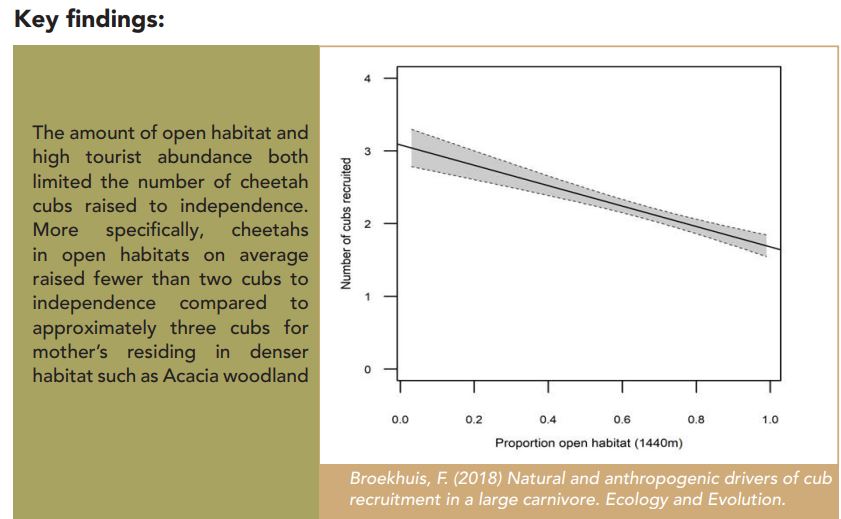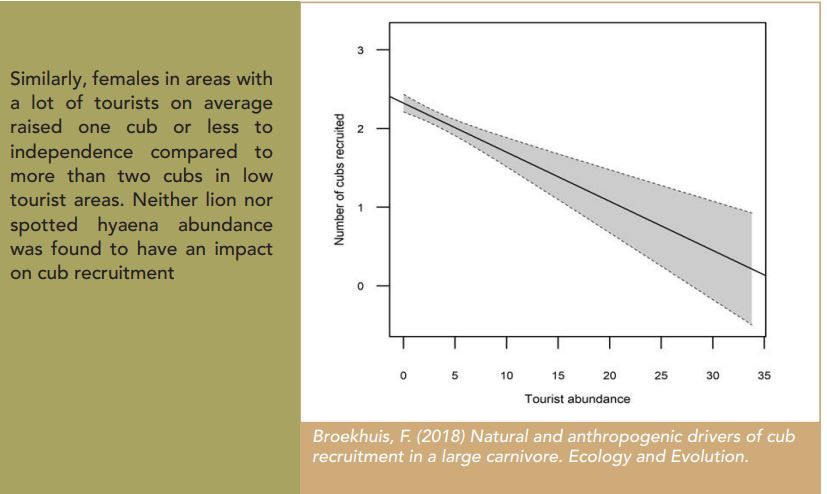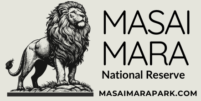The Mara Predator Conservation Programme (MPCP) recently published two significant scientific papers detailing findings on cheetah conservation in the Maasai Mara. These studies provide insights into the impact of tourism and habitat on cheetah cub survival and habitat preferences based on cheetah collar data. Below is a summary of the key findings and recommendations from these papers.
Key Findings
Impact of Tourism and Habitat on Cheetah Cub Survival
Authored by: Dr. Femke Broekhuis
Objective: To determine the effects of habitat type, tourist abundance, lion abundance, and spotted hyena presence on the number of cheetah cubs that reach independence.
Findings:
- Habitat Impact: Cheetahs in open habitats raised fewer than two cubs to independence, compared to approximately three cubs in denser habitats like Acacia woodland.
- Tourism Impact: High tourist abundance negatively affected cub survival. In areas with many tourists, cheetah mothers raised on average one cub or less to independence, compared to more than two cubs in areas with fewer tourists.
- Predator Impact: Neither lion nor spotted hyena abundance significantly impacted cheetah cub recruitment.
Identifying Suitable Habitats for Cheetahs
Authored by: Britt Klaassen and Dr. Femke Broekhuis
Summary:https://www.marapredatorconservation.org/wp-content/uploads/2018/07/MPCP-Q2-Report.pdf

Objective: To identify suitable habitats for cheetahs by determining their preferences and aversions, focusing on human presence and habitat types.
Findings:
- Human Presence: Cheetahs strongly preferred protected areas and avoided areas with human settlements, livestock enclosures, dams, towns, and agricultural land, suggesting humans are perceived as a significant threat.
- Habitat Preferences: Cheetahs favored semi-closed habitats (e.g., Acacia woodland, mixed scrub) and areas with high edge density between open and semi-closed habitats, likely for cover and increased hunting success. They avoided steep slopes due to limitations on hunting abilities.
- Protected Areas: Cheetahs rarely left protected areas despite proximity to boundaries, indicating a strong preference for these safer environments.

Recommendations
Habitat Management
- Diverse Habitats: Ensure a variety of habitat types, especially semi-closed habitats, are available within conservation areas. Avoid creating too much open space through overgrazing or burning, which can negatively impact cheetah cub recruitment.
- Habitat Protection: Protect dense vegetation patches both inside and outside protected areas to provide necessary cover for cheetahs.
Tourism Management
- Viewing Guidelines: Implement strict guidelines to minimize tourist impact on cheetahs. Recommendations include:
- Limiting to five vehicles at a cheetah sighting.
- Prohibiting tourist vehicles near cheetah lairs.
- Maintaining a minimum distance of 30 meters from cheetahs.
- Keeping noise levels and disturbances low at sightings.
- Ensuring vehicles do not separate mothers and cubs or enclose cheetahs on a kill.
Conservation Planning
- Protected Area Expansion: Consider expanding current conservancies and creating new ones, including wildlife corridors, to ensure habitat connectivity.
- Spatial Planning: Develop a spatial plan for the Maasai Mara region that includes regulations on human development to minimize negative impacts on cheetah habitats.
- Community Involvement: Ensure that land protection schemes consider the needs of local communities to avoid resentment and displacement. Engage local people in conservation efforts to foster tolerance towards cheetahs and other predators outside protected areas.
Further Research
- Connectivity Areas: Conduct additional research to identify potential areas outside protected zones that could serve as effective wildlife corridors.
- Human Development: Monitor and regulate human development activities to balance conservation needs and local community interests.
Relation to Narok County Mara Management Plan
Narok County Mara Management Plan Objectives:
- Sustainable Tourism: Promote eco-friendly tourism benefiting the ecosystem and local communities.
- Habitat Conservation: Protect and restore critical wildlife habitats for ecosystem sustainability.
- Community Benefits: Ensure local communities gain from conservation efforts through improved livelihoods and infrastructure.
Alignment with MPCP Objectives:
- Shared Goals: Both MPCP and the Narok County Mara Management Plan aim to balance wildlife conservation with community development.
- Collaborative Efforts: MPCP’s community engagement and conflict mitigation activities directly support the plan’s objective of community benefits.
- Sustainable Practices: MPCP’s promotion of predator conservation aligns with the plan’s focus on sustainable tourism and habitat conservation.
Complementary Aspects of Narok’s Management Plan and MPCP Recommendations
Overview of Narok County Mara Management Plan Objectives
Narok County Mara Management Plan Objectives:
- Sustainable Tourism: Promote eco-friendly tourism practices that benefit both the ecosystem and local communities.
- Habitat Conservation: Protect and restore critical wildlife habitats to ensure the long-term sustainability of the ecosystem.
- Community Benefits: Ensure that local communities benefit from conservation efforts through improved livelihoods and infrastructure.
Complementary Aspects
1. Habitat Management
MPCP Recommendation:
- Ensure a variety of habitat types, especially semi-closed habitats, are available within conservation areas.
- Protect dense vegetation patches both inside and outside protected areas.
Narok Management Plan:
- Habitat Conservation: The plan prioritizes protecting and restoring critical wildlife habitats, aligning with MPCP’s emphasis on maintaining diverse and dense habitats necessary for cheetah cub survival. By incorporating diverse habitats into land management practices, both plans work towards creating a sustainable environment for cheetahs and other wildlife.
2. Tourism Management
MPCP Recommendation:
- Implement strict guidelines to minimize tourist impact on cheetahs, such as limiting the number of vehicles at sightings and maintaining a safe distance.
Narok Management Plan:
- Sustainable Tourism: Promoting eco-friendly tourism practices includes regulating tourist activities to minimize negative impacts on wildlife. This aligns with MPCP’s recommendations for strict viewing guidelines to protect cheetahs from excessive tourist disturbance, ensuring a balanced approach that supports both conservation and tourism.
3. Community Engagement and Benefits
MPCP Recommendation:
- Engage local communities in conservation efforts and ensure land protection schemes consider their needs to avoid resentment and displacement.
Narok Management Plan:
- Community Benefits: The plan emphasizes that local communities should benefit from conservation efforts. By improving livelihoods and infrastructure, the plan fosters local support for conservation initiatives. This is complementary to MPCP’s focus on community engagement and the importance of considering community needs in conservation strategies, promoting a harmonious coexistence between wildlife and local populations.
4. Protected Area Expansion and Connectivity
MPCP Recommendation:
- Expand current conservancies and create new ones, including wildlife corridors, to ensure habitat connectivity.
- Develop a spatial plan for the Maasai Mara region to include regulations on human development.
Narok Management Plan:
- Habitat Conservation and Sustainable Tourism: The plan’s objectives to protect and restore wildlife habitats naturally support the expansion of protected areas and connectivity. It promotes integrated land-use planning, ensuring that human development does not compromise critical habitats. This aligns with MPCP’s recommendation to prioritize habitat connectivity and manage human activities that could impact wildlife corridors.
5. Conflict Mitigation and Policy Development
MPCP Recommendation:
- Implement strategies to reduce human-wildlife conflict and advocate for policies that support predator conservation.
Narok Management Plan:
- Community Benefits and Sustainable Tourism: By improving local infrastructure and livelihoods through sustainable tourism, the plan helps mitigate human-wildlife conflicts. Policy advocacy is also crucial, as the plan supports regulations and guidelines that protect wildlife while fostering economic development, thus complementing MPCP’s efforts in policy advocacy and conflict resolution.
Conclusion
The recent findings from MPCP highlight critical aspects of cheetah conservation in the Maasai Mara, particularly the impact of habitat type and tourist pressure on cub survival. The recommendations emphasize the importance of diverse habitats, regulated tourism, and comprehensive conservation planning. Aligning with the Narok County Mara Management Plan, these strategies aim to foster sustainable conservation efforts that benefit both wildlife and local communities.
